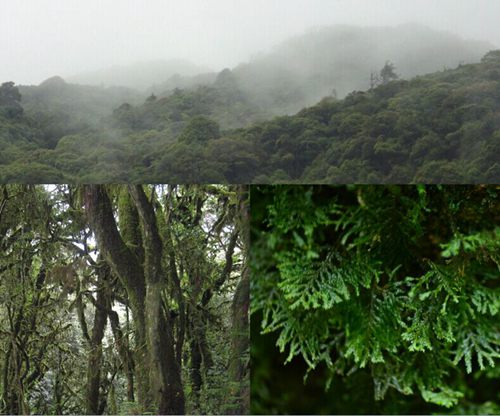J Plant Res:中科院版纳植物园刘文耀研究组揭示扇型苔藓植物的光
生活型是生物对外界环境适应的外部表现形式。苔藓植物属于独立营养、直接从大气中吸收水分的生活类型。苔藓植物的群集方式及其生长型的全部特征被定义为苔藓植物的生活型(Life form),扇形(fan)是其中代表性的生活型之一,它们通常生于垂直的生长基质上,分枝向水平方向生长形成一个类似于“扇子”的平坦光合表面。这类苔藓 “站立”在树干上,与大气全面接触,这样的一种独特的形态结构可能有利于其从空气中截留水分,并最大限度地获取光资源。然而,目前对这类特殊植物的水分关系和气体交换特征及其对微生境的适应鲜有系统研究。
中国科学院西双版纳热带植物园恢复生态研究组博士宋亮、研究员刘文耀及其合作者,对云南哀牢山中山湿性常绿阔叶林中三个扇型苔藓优势种的失水曲线、P-V曲线、光合水分和光响应曲线及其所处生境下的微气候条件进行了系统的测定和分析研究。结果表明,干燥空气中,饱和吸水的苔藓样本在一个小时内丧失其所有自由水分。扇型苔藓具有较高的细胞壁弹性和渗透调节能力来应对干旱,且这类苔藓具有较低的光补偿点和光饱和点,反映出其适应荫蔽环境的特征。哀牢山地区较高的年降雨量、潮湿多雾的气候条件,以及连片的原始森林孕育了丰富、多样的苔藓植物及其它附生植物。然而,由于扇形苔藓植物水分保留能力较差,且其光合速率对水分供应状况具有高度依赖性,暗示干旱频率及程度的增加可能对这类苔藓植物的碳收支及生长造成较大的影响。研究得到国家自然科学基金、NSFC—云南联合基金、中科院“西部之光”和青年创新促进会项目的共同资助。哀牢山生态站对本研究也给予了支持。

研究区概况及扇型苔藓植物

扇形苔藓植物的光合水分和光响应曲线
原文链接:
Water relations and gas exchange of fan bryophytes and their adaptations to microhABItats in an Asian subtropical montane cloud forest
原文摘要:
Fan life forms are bryophytes with shoots rising from vertical substratum that branch repeatedly in the horizontal plane to form flattened photosynthetic surfaces, which are well suited for intercepting water from moving air. However, detailed water relations, gas exchange characteristics of fan bryophytes and their adaptations to particular microhabitats remain poorly understood. In this study, we measured and analyzed microclimatic data, as well as water release curves, pressure–volume relationships and photosynthetic water and light response curves for three common fan bryophytes in an Asian subtropical montane cloud forest (SMCF). Results demonstrate high relative humidity but low light levels and temperatures in the understory, and a strong effect of fog on water availability for bryophytes in the SMCF. The facts that fan bryophytes in dry air lose most of their free water within 1 h, and a strong dependence of net photosynthesis rates on water content, imply that the transition from a hydrated, photosynthetically active state to a dry, inactive state is rapid. In addition, fan bryophytes developed relatively high Cell wall elasticity and the osmoregulatory capacity to tolerate desiccation. These fan bryophytes had low light saturation and compensation point of photosynthesis, indicating shade tolerance. It is likely that fan bryophytes can flourish on tree trunks in the SMCF because of substantial annual precipitation, average relative humidity, and frequent and persistent fog, which can provide continual water sources for them to intercept. Nevertheless, the low water retention capacity and strong dependence of net photosynthesis on water content of fan bryophytes indicate a high risk of unbalanced carbon budget if the frequency and severity of drought increase in the future as predicted.
DOI:10.1007/s10265-015-0721-z
作者:刘文耀

